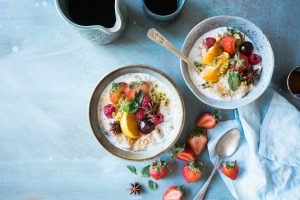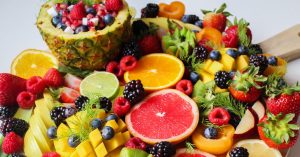In the world of food, taste and texture are like Siamese twins – inseparable. They virtually work hand in hand to create delicious culinary experiences. If you imagine that all the individual components of a meal or snack only had the consistency of mashed potato – that would be pretty monotonous, wouldn’t it?
The combination of different textures increases the complexity of a dish and takes the culinary experience to another level. While taste defines flavor, texture adds depth and excitement to the sensory experience of eating. However, understanding these elements not only enriches our enjoyment experience, but also drives innovation in the culinary world.

Table of contents
How taste and texture inspire each other

As soon as we put food in our mouths, our senses come to life. The taste of food – often the first attribute we think of – is complemented by texture, which enhances our overall sense of flavor. The crispy crunch of potato chips or the creamy smoothness of chocolate – these textures not only contribute significantly to the taste, but they also influence the overall experience and make every bite that much more satisfying.
Crunchy texture can even help you lose weight
According to a US study, foods that make noise when chewed can even help you lose weight – through the so-called “crunch effect”: researchers at Brigham Young University in the US state of Utah1 have found that you should block out distracting background noises during your meals and instead focus on foods that crunch and crackle when you bite and chew. Marketing lecturer Ryan Elder and his team found that people unconsciously eat less as a result. The scientists call this the “crunch effect”.
How does the “Crunch effect” work?
The explanation is relatively simple: when we eat food that makes loud noises when we chew, it distracts us and we focus more on the sounds than on the taste. In addition, the cracking sounds signal that we are eating something solid, which our brain associates with satiety. So we eat more slowly and stop earlier because we feel fuller.

Food Texture - What does it mean?
The term ‘food texture’ refers to the mouthfeel that arises while we chew and swallow food. It is a complex sensory experience that involves our nerve endings. Our receptors detect temperature, touch, and pressure, and play a key role in how we perceive our food.
Various properties of texture
- Viscosity: the thickness of a liquid or the resistance of a substance to flowing
- Elasticity: the ability of a food to return to its original shape after deformation
- Cohesiveness: the degree to which a food holds together
Adhesiveness: the degree to which a food adheres to surfaces in the mouth - Firmness: the amount of force required to compress a food product
- Bounce: the ability of a food to spring back into shape after compression
- Moistur: the amount of water present in a food product

Various types of textures

The wide variety of food textures is astonishing. From crispy to creamy, from chewy to juicy – each texture brings its own unique pleasure to the palate. For example, biting into a crunchy apple offers a different sensation than enjoying the velvety richness of ice cream (preferably with whipped cream). These are the 12 most well-known types of textures:
- Crispy/crumbly/crunchy
- Firm/Hard/Soft
- Creamy/chewy/sticky
- Juicy/Watery/Moist
Popular textures and the corresponding foods
- Crunchy: crispy potato chips, corn flakes, cookies, pretzel sticks
- Crispy: Fresh vegetables such as celery or carrots, nuts
- Creamy: Creamy mashed potatoes, silky chocolate mousse, ice cream
- Sticky/chewy: gummy sweets, caramel sweets, liquorice, honey
- Juicy/watery: watermelon, oranges, tomatoes

Sensory impressions due to certain textures
Certain textures of food evoke strong sensory memories in us. Who could ever forget the tingling mouthfeel of carbonated bubbles or the viscous pleasure of snacking on gummy bears? Texture plays a crucial role when it comes to our nostalgic memories. It also makes eating fun. It’s not just about taste and texture: it’s about creating and recreating lasting memories of happy holidays, lively parties and childhood fun.
Studies show that the texture of food significantly influences the taste sensation. Texture modifiers can enhance the taste experience by changing the perception of flavor. For example, a smooth texture can make a food seem richer, while a chewy texture is often associated with sweet treats and increases their indulgent appeal.
Paradise Fruits products with unique textures
At Paradise Fruits, we also intentionally use a variety of textures to enhance the taste of our products and sustainably increase customer satisfaction.
Discover our products
– Creamy/smooth texture: High Brix Paste
– Juicy texture: Fruit Juice Drops
– Chewy/elastic texture: Fruit Shapes
Our innovative ingredients and their diverse textures can be used in a variety of ways, whether as a snack or in baked goods, chocolate, cereal bars, cereals, or other products.
Contact us, we will be happy to advise you!
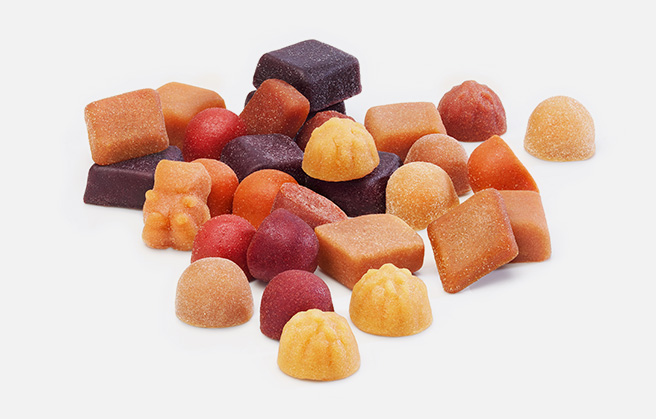
Food Texture – Analysis and Integration
Measuring the texture of food
Texture analysis is used for all types of food, from baked goods to pet food. It is an indispensable tool for the food industry to ensure and improve the quality and consistency of its products. From development to production, it provides valuable insights into the physical properties of food and its sensory perception by the consumer. By using modern analysis methods, manufacturers can find the perfect texture for their products and thus increase customer satisfaction.
Integration of food texture
As texture is related to the sense of touch, it can be easily measured using mechanical methods and expressed in units such as force.
Standardized test methods such as compression, tensile and bending tests are used to quantify properties such as hardness, crispness, crunchiness, softness, elasticity or stickiness.

Correlation to sensory perception
When comparing the results of the mechanical texture analysis, it was found that the measurements almost always correspond to the various sensory properties associated with texture quality. This shows the relevance of texture analysis for the assessment of product quality from the consumer’s point of view.
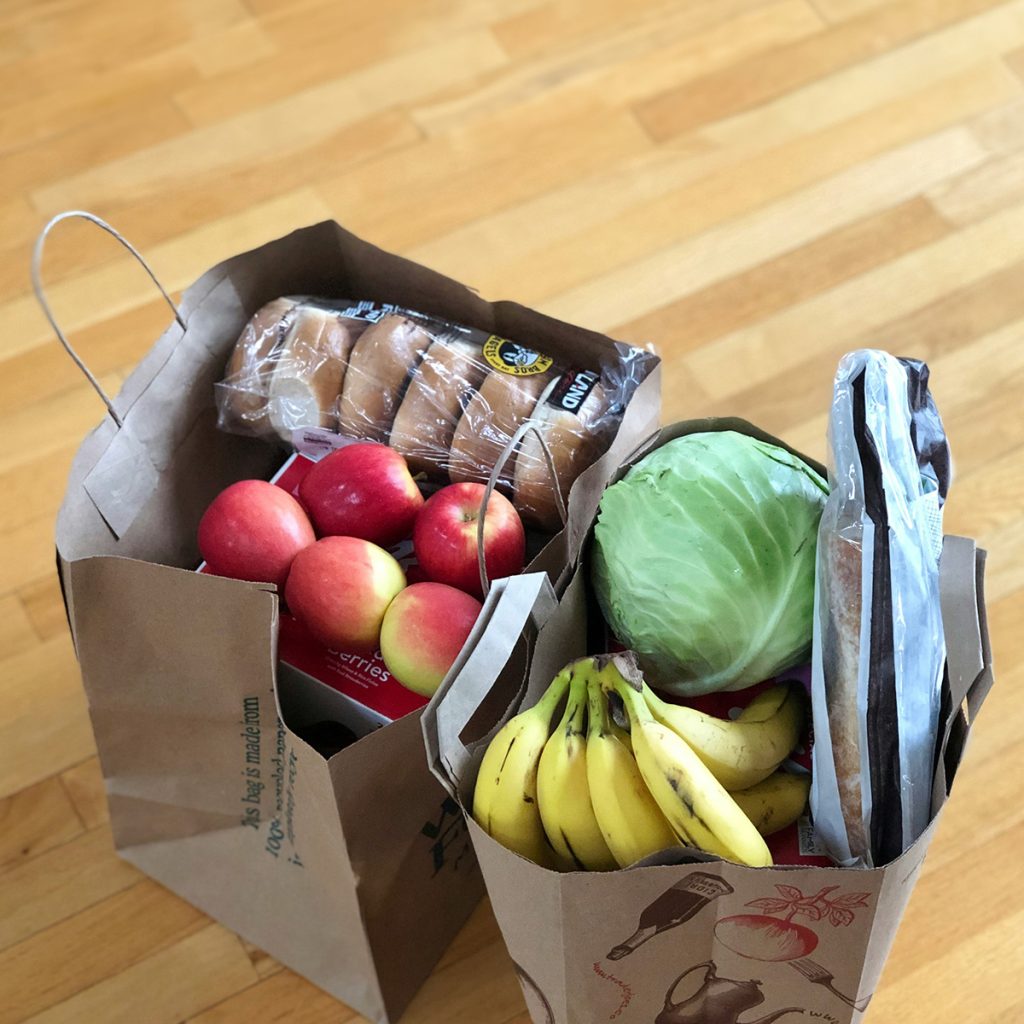
Use along the value chain
For natural products such as fruit, vegetables, meat and fish, the texture properties can be traced back to the way in which the product was grown or the animal was bred. For processed foods, texture analysis can be used to optimize production processes.
In the research and development phase, new or alternative ingredients can be compared with existing ones to find the best possible texture. In production, food texture analysis is used to measure and control variables such as temperature, humidity and cooking time to ensure consistent product quality.
Innovative food companies such as Paradise Fruits deliberately use different textures to increase customer satisfaction. Their range includes creamy/smooth High Brix Paste, juicy Fruit Juice Drops and chewy fruit gums in various shapes.
By deliberately combining textures, they elevate everyday snacks to premium experiences: For example, the creamy High Brix Paste can be incorporated into baked goods or chocolate to give them a particularly rich and creamy note. The delicious fruit granules are ideal as a filling for muffins or cookies and provide a refreshing taste experience.
Texture and food innovation
Today’s culinary landscape is characterized by the search for exciting and varied textures. From crunchy caramelized toppings on desserts to the velvety smoothness of ice cream or panna cotta, textures create exciting contrasts. These innovations not only satisfy our taste buds, but also offer new ways to enjoy food.
Paradise Fruits is constantly on the lookout for texture innovations to give products that certain something. When developing new fruit shapes, the product developers at Paradise Fruits are also inspired by new textures: They experiment with different recipes and manufacturing processes. One example: the unique shapes with Rice Crispies, which turn a normal fruit gum snack into a crunchy surprise.
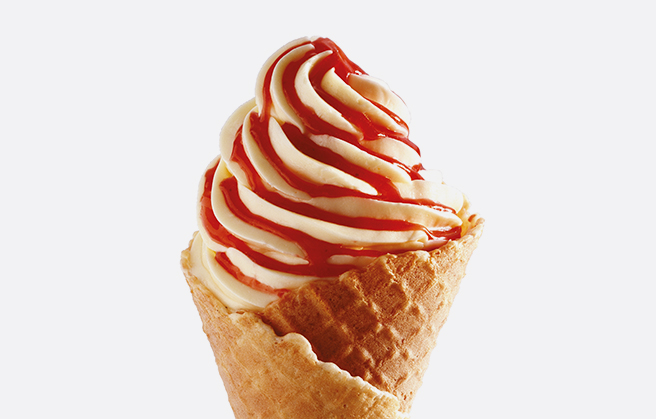
Conclusion
Paradise Fruits offers numerous innovative texture solutions to give a wide variety of products that certain something. After all, taste and texture form a dynamic duo that defines indulgence. Understanding and appreciating these elements also inspires innovation in the food industry.
Next time you eat your favorite snack, pay attention to the interplay of taste and texture – it’s the key to culinary enjoyment. And if you are looking for new texture experiences, take a look at the innovative Paradise Fruits range. You’re guaranteed to find the perfect texture for your next product!
Sources:
¹ „Abnehmen mit Crunch: Geräuschvolles Essen macht schlank“, fitforfun.de (o. J.). https://www.fitforfun.de/abnehmen/abnehmen-mit-crunch-geraeuschvolles-essen-macht-schlank-212873.html
Image sources in the order shown:
Febrian Zakaria, Yulia Khlebnikova, Icons8 Team, Claudio Schwarz – from unsplash.com
Product picture 1 – Paradise Fruits Solutions
Krisztina Papp, Art Rachen – from unsplash.com
Product picture 2 – Paradise Fruits Solutions
Logan Isbell, Maria Lin Kim – from unsplash.com
Product picture 3 – Paradise Fruits Solutions
Frequently asked questions (FAQ) about taste and texture in food
Why are taste and texture so important in food?
Flavor and texture are inextricably linked and work together to create a holistic overall experience. While flavor defines the aroma, texture adds depth and excitement, making the food more interesting and satisfying.
What is food texture?
Food texture refers to the mouthfeel and structure of food, including the consistency we feel when chewing and swallowing. It includes properties such as crunchiness, chewiness, creaminess and juiciness.
How does texture influence the taste of food?
The texture of a food can significantly influence the perception of its taste. For example, a creamy texture can enhance flavor perception, while a crunchy texture can create interesting contrasts.
Why is it important to measure the texture of food?
Measuring texture provides important information about the quality of food, including its sensory properties. By understanding these properties, food manufacturers can optimize their products to increase customer satisfaction.
What role does texture play in food innovation?
The search for new and exciting textures is an important driver of food innovation. By combining different textures, innovative products can be created that offer new taste experiences.
How can companies optimize the texture of their products?
Food producers specifically use different textures to improve the taste and customer satisfaction of their products. This is because the variety of textures offers the opportunity to create unique taste experiences.
These FAQs provide an insight into the importance of taste and texture in food and the role of texture analysis in product development. If you want to learn more about innovative textures and flavor combinations, explore the Paradise Fruits range for inspiring new taste experiences or contuct us.

